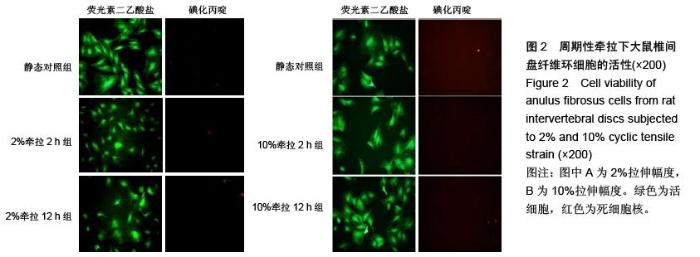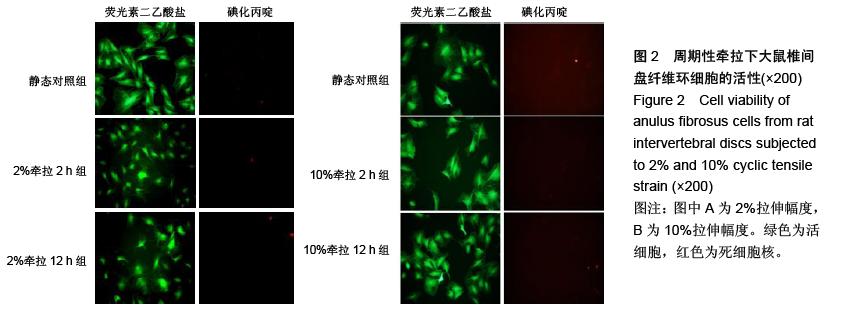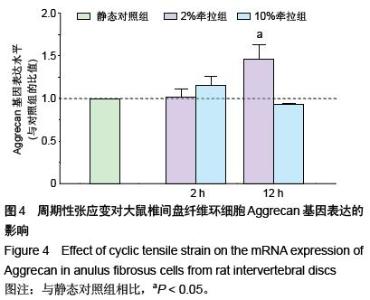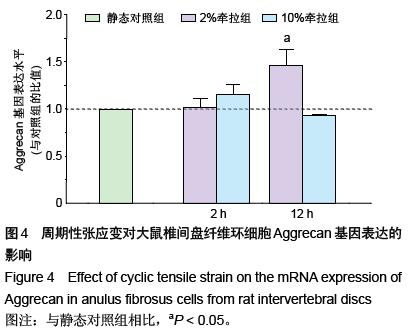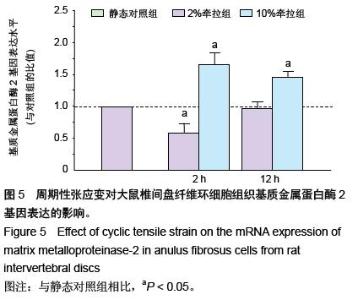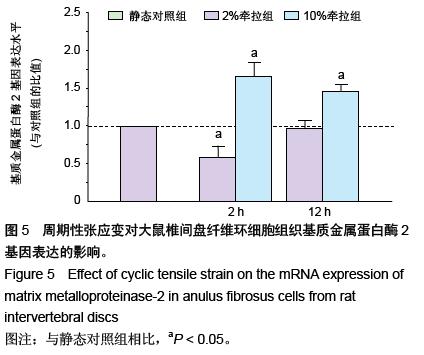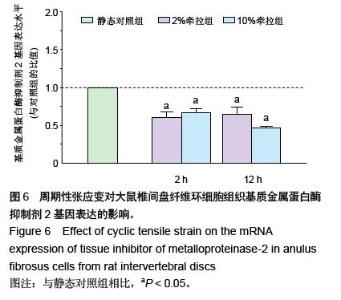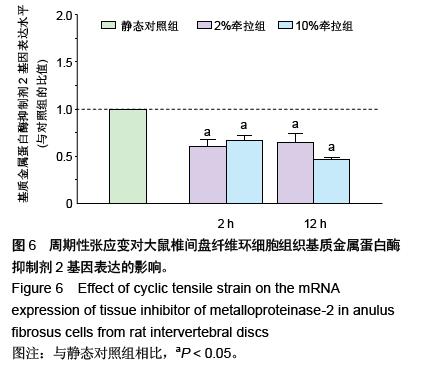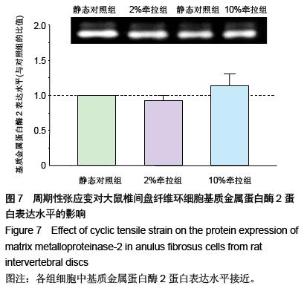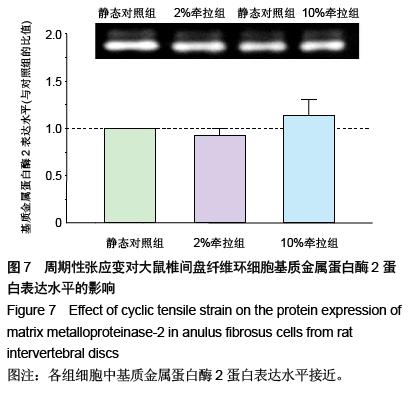| [1] Rannou F, Richette P, Benallaoua M, et al. Cyclic tensile stretch modulates proteoglycan production by intervertebral disc annulus fibrosus cells through production of nitrite oxide. J Cell Biochem. 2003;90(1): 148-157.
[2] Sowa G, Coelho P, Vo N, et al. Determination of annulus fibrosus cell response to tensile strain as a function of duration, magnitude, and frequency. J Orthop Res. 2011; 29(8):1275-1283.
[3] Vo NV, Hartman RA, Yurube T, et al. Expression and regulation of metalloproteinases and their inhibitors in intervertebral disc aging and degeneration. Spine J. 2013;13(3):331-341.
[4] Rastogi A, Kim H, Twomey JD, et al. MMP-2 mediates local degradation and remodeling of collagen by annulus fibrosus cells of the intervertebral disc. Arthritis Res Ther. 2013;15(2):R57.
[5] Zhang Y, Gu Z, Qiu G. Association of the polymorphism of MMP2 with the risk and severity of lumbar disc degeneration in the Chinese Han population. Eur Rev Med Pharmacol Sci. 2013;17(13):1830-1834.
[6] Crean JK, Roberts S, Jaffray DC, et al. Matrix metalloproteinases in the human intervertebral disc: role in disc degeneration and scoliosis. Spine (Phila Pa 1976). 1997;22(24):2877-2884.
[7] Rutges JP, Kummer JA, Oner FC, et al. Increased MMP-2 activity during intervertebral disc degeneration is correlated to MMP-14 levels. J Pathol. 2008;214(4): 523-530.
[8] Hsieh AH, Lotz JC. Prolonged spinal loading induces matrix metalloproteinase-2 activation in intervertebral discs. Spine (Phila Pa 1976). 2003;28(16):1781-1788.
[9] Kozaci LD, Guner A, Oktay G, et al. Alterations in biochemical components of extracellular matrix in intervertebral disc herniation: role of MMP-2 and TIMP-2 in type II collagen loss. Cell Biochem Funct. 2006;24(5):431-436.
[10] Omlor GW, Lorenz H, Engelleiter K, et al. Changes in gene expression and protein distribution at different stages of mechanically induced disc degeneration--an in vivo study on the New Zealand white rabbit. J Orthop Res. 2006;24(3):385-392.
[11] 郭志良,周跃,李华壮,等.周期性张应变对纤维环细胞AggrecanmRNA表达的影响[J].重庆医学,2007,36(6): 545-547.
[12] Watanabe H, Nakata K, Kimata K, et al. Dwarfism and age-associated spinal degeneration of heterozygote cmd mice defective in aggrecan. Proc Natl Acad Sci U S A. 1997;94(13):6943-6947.
[13] Skaggs DL, Weidenbaum M, Iatridis JC, et al. Regional variation in tensile properties and biochemical composition of the human lumbar anulus fibrosus. Spine (Phila Pa 1976). 1994;19(12):1310-1319.
[14] Yurube T, Takada T, Suzuki T, et al. Rat tail static compression model mimics extracellular matrix metabolic imbalances of matrix metalloproteinases, aggrecanases, and tissue inhibitors of metalloproteinases in intervertebral disc degeneration. Arthritis Res Ther. 2012;14(2):R51.
[15] Sowa GA, Coelho JP, Bell KM, et al. Alterations in gene expression in response to compression of nucleus pulposus cells. Spine J. 2011;11(1):36-43.
[16] Liu B, Qu MJ, Qin KR, et al. Role of cyclic strain frequency in regulating the alignment of vascular smooth muscle cells in vitro. Biophys J. 2008;94(4):1497-1507.
[17] Hamilton DJ, Pilliar RM, Waldman S, et al. Effect of circumferential constraint on nucleus pulposus tissue in vitro. Spine J. 2010;10(2):174-183.
[18] Zhang YH, Zhao CQ, Jiang LS, et al. Substrate stiffness regulates apoptosis and the mRNA expression of extracellular matrix regulatory genes in the rat annular cells. Matrix Biol. 2011;30(2):135-144.
[19] Gantenbein B, Grünhagen T, Lee CR, et al. An in vitro organ culturing system for intervertebral disc explants with vertebral endplates: a feasibility study with ovine caudal discs. Spine (Phila Pa 1976). 2006;31(23): 2665-2673.
[20] Neidlinger-Wilke C, Mietsch A, Rinkler C, et al. Interactions of environmental conditions and mechanical loads have influence on matrix turnover by nucleus pulposus cells. J Orthop Res. 2012;30(1):112-121.
[21] Le Maitre CL, Freemont AJ, Hoyland JA. Human disc degeneration is associated with increased MMP 7 expression. Biotech Histochem. 2006;81(4-6):125-131.
[22] Walter BA, Korecki CL, Purmessur D, et al. Complex loading affects intervertebral disc mechanics and biology. Osteoarthritis Cartilage. 2011;19(8): 1011-1018.
[23] Iatridis JC, MacLean JJ, Roughley PJ, et al. Effects of mechanical loading on intervertebral disc metabolism in vivo. J Bone Joint Surg Am. 2006;88 Suppl 2:41-46.
[24] Wilder-Smith P, Lee K, Guo S, et al. In vivo diagnosis of oral dysplasia and malignancy using optical coherence tomography: preliminary studies in 50 patients. Lasers Surg Med. 2009;41(5):353-357.
[25] Amaechi BT, Higham SM, Podoleanu AG, et al. Use of optical coherence tomography for assessment of dental caries: quantitative procedure. J Oral Rehabil. 2001;28(12):1092-1093.
[26] Popescu DP, Sowa MG, Hewko MD, et al. Assessment of early demineralization in teeth using the signal attenuation in optical coherence tomography images. J Biomed Opt. 2008;13(5):054053.
[27] 李爽,马信龙,孙晓雷,等.循环牵张应力对人退变纤维环细胞增殖的影响[J].国际生物医学工程杂志,2011,34(6): 344-361.
[28] Gruber HE, Hoelscher GL, Ingram JA, et al. Variations in aggrecan localization and gene expression patterns characterize increasing stages of human intervertebral disk degeneration. Exp Mol Pathol. 2011;91(2):534-539.
[29] Cho H, Seth A, Warmbold J, et al. Aging affects response to cyclic tensile stretch: paradigm for intervertebral disc degeneration. Eur Cell Mater. 2011;22:137-145; discussion 145-146.
[30] 郭志良,周跃,滕海军,等.周期性张应变下调椎间盘纤维环细胞Aggrecan mRNA表达的分子机制研究[J].中华物理医学与康复杂志,2012,34(10):791-793.
[31] Wu WP, Jiang JM, Qu DB, et al. Expression of hypoxia-inducible factor-1alpha and matrix metalloproteinase-2 in degenerative lumbar intervertebral disc. Nan Fang Yi Ke Da Xue Xue Bao. 2010;30(5):1152-1155.
[32] 綦惠,赵丹慧,田伟.基质金属蛋白酶与椎间盘退变研究的新进展[J].中国脊柱脊髓杂志,2010,20(1):69-72.
[33] Vo NV, Hartman RA, Yurube T, et al. Expression and regulation of metalloproteinases and their inhibitors in intervertebral disc aging and degeneration. Spine J. 2013;13(3):331-341.
[34] 范东伟,陈仲强,郭昭庆,等.周期性牵张应力对人椎间盘纤维环细胞合成和分解的影响[J].天津医药,2014,42(3): 241-244.
[35] Gilbert HT, Nagra NS, Freemont AJ, et al. Integrin - dependent mechanotransduction in mechanically stimulated human annulus fibrosus cells: evidence for an alternative mechanotransduction pathway operating with degeneration. PLoS One. 2013;8(9):e72994.
[36] Liu C, Feng P, Li X, et al. Expression of MMP-2, MT1-MMP, and TIMP-2 by cultured rabbit corneal fibroblasts under mechanical stretch. Exp Biol Med (Maywood). 2014;239(8):907-912.
[37] Gilbert HT, Hoyland JA, Millward-Sadler SJ. The response of human anulus fibrosus cells to cyclic tensile strain is frequency-dependent and altered with disc degeneration. Arthritis Rheum. 2010;62(11):3385-3394.
[38] Tian Y, Yuan W, Fujita N, et al. Inflammatory cytokines associated with degenerative disc disease control aggrecanase-1 (ADAMTS-4) expression in nucleus pulposus cells through MAPK and NF-κB. Am J Pathol. 2013;182(6): 2310-2321.
[39] Pratsinis H, Constantinou V, Pavlakis K, et al. Exogenous and autocrine growth factors stimulate human intervertebral disc cell proliferation via the ERK and Akt pathways. J Orthop Res. 2012;30(6):958-964.
[40] 郭志良,周跃,滕海军,等. JNK及P38信号分子在周期性张应变下调大鼠椎间盘纤维环细胞Aggrecan mRNA表达中的作用[J].中国矫形外科杂志,2013,21(19):1977-1981.
[41] Yang SH, Sharrocks AD, Whitmarsh AJ. MAP kinase signalling cascades and transcriptional regulation. Gene. 2013;513(1):1-13.
[42] 邹隆强.MAPK信号传导通路在髓核细胞研究进展[J].中国矫形外科杂志,2012,20(21):1963-1965.
[43] Campbell JJ, Blain EJ, Chowdhury TT, et al. Loading alters actin dynamics and up-regulates cofilin gene expression in chondrocytes. Biochem Biophys Res Commun. 2007;361(2): 329-334.
[44] Fanning PJ, Emkey G, Smith RJ, et al. Mechanical regulation of mitogen-activated protein kinase signaling in articular cartilage. J Biol Chem. 2003; 278(51):50940-50948.
[45] Ren K, Liu F, Huang Y, et al. Periodic mechanical stress activates integrinβ1-dependent Src-dependent PLCγ1-independent Rac1 mitogenic signal in rat chondrocytes through ERK1/2. Cell Physiol Biochem. 2012;30(4):827-842.
[46] Li W, Duzgun A, Sumpio BE, et al. Integrin and FAK-mediated MAPK activation is required for cyclic strain mitogenic effects in Caco-2 cells. Am J Physiol Gastrointest Liver Physiol. 2001;280(1):G75-87.
[47] Plotkin LI, Mathov I, Aguirre JI, et al. Mechanical stimulation prevents osteocyte apoptosis: requirement of integrins, Src kinases, and ERKs. Am J Physiol Cell Physiol. 2005;289(3):C633-643. |
